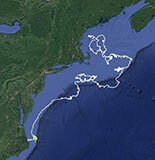
A Marine Science Department device that gauges ocean currents off New England has drifted some 600 miles to the south — all the way to North Carolina, where it was brought ashore and repaired by a charter boat fisherman who is featured on the National Geographic show, “Wicked Tuna.”
In February, Marine Science students built what is known as an ocean drifter as part of an ongoing project in partnership with the federal NOAA Fisheries agency and the Gulf of Maine Lobster Foundation. The contraption is essentially a long piece of wood with four vinyl sails attached to its four sides that drifts in the water. It is powered by the sails that capture the water currents much the way a sailboat is propelled by sails that capture the wind.
It is equipped with a solar-powered satellite transponder that reports its position every six hours, allowing people to track its ocean journey online.
The Marine Science Department has built and launched about a dozen of the drifters through the years, with virtually all of them floating northeast in the Gulf Stream to the Grand Banks off of Newfoundland, said Marine Science Professor Brian Tarbox.
The latest drifter was launched Feb. 24 and ended up being caught in a countercurrent that took it hundreds of miles southwest until, on Sept. 30, it appeared to make its way onto land. Tarbox zoomed in on the transponder location and determined the drifter was in a yard behind a house in a small town on the Outer Banks of North Carolina.
He pinpointed the address, called the local tax assessor and eventually tracked the property to Greg Mayer, a charter boat fisherman who has appeared on “Wicked Tuna” for the past six seasons.
Mayer told Campus Connections he saw the drifter while fishing about 34 miles offshore and pulled it aboard his 53-foot boat, Fishin’ Frenzy. Two of the drifter’s four sails were broken, he said, so he brought it ashore.
He tried calling the phone number that was written on the drifter, but it was largely illegible and he got the wrong number a few times. But he hoped that the transponder was still working, so he placed it in his backyard and was pleased when Tarbox tracked him down.
Mayer volunteered to repair the drifter’s sails and then launched it back into the ocean early last week.
With the drifter now at sea, Tarbox is guessing that it will drift south before entering the Gulf Stream and heading back in a northeasterly direction. For now, he’s thankful that Mayer lent a helping hand.
“He was pretty interested in it and was glad to help out,” Tarbox said.
People can track the drifter by going to NOAA Fisheries 2020 Drifter website.

